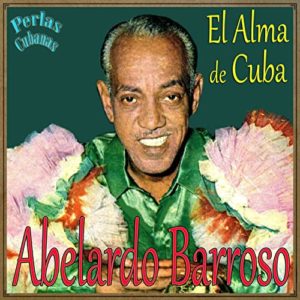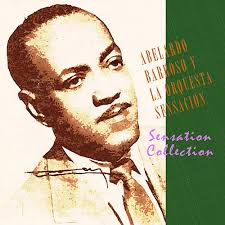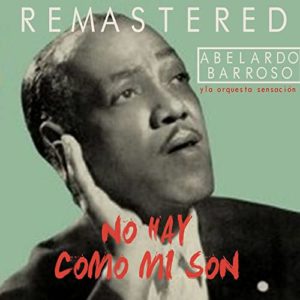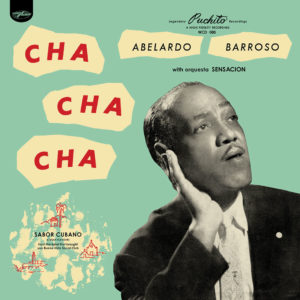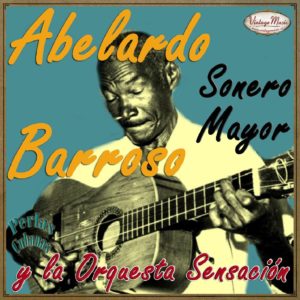ABELARDO BARROSO, ONE OF THE BEST VOICES “SONERAS” OF CUBA
Abelardo Barroso Dargeles was born in Havana (1905), in the Cayo Hueso neighborhood – the cradle of famous rumberos and soneros. The famous interpreter of Cuban music and legendary sonero.
From a very young age, he was forced to earn a living in various trades but in his spare time, he would sing with troubadours who performed in Havana cafes, or with soneros groups that performed in small and precarious cabarets on Marianao Beach, redoubts. fringes of the son – born in the mountains of the eastern region.
On the beach in Marianao, the young Abelardo Barroso met soneros who were going to transform Cuban popular music from the moment the new genre began to be recorded on discs.
Barroso actively participated in the phonographic debut of the most prominent soneros groups of the so-called “golden age”.
ARTISTIC CAREER
On July 17, 1925, Abelardo Barroso joined the Habanero Sextet, which was then performing at the exclusive Vedado Lawn Tennis Club. On October 29 of the same year, the Sextet made its first recordings in Havana, for the RCA Victor firm. The second recording session took place on November 2, when one of the sounds considered “classic” was printed: ‘A la Loma de Belén’, by Juana González de Cabrera. These records are among the first non-acoustic phonograph records to be made on the island.
https://youtu.be/nHm-9-H8qzk
ABELARDO BARROSO SINGS “DAME UN TRAGO..” (VIDEOS)
In the first recordings of the Sexteto Habanero, Abelardo Barroso sang and played the keys. In 1926 he joined the group of the bongo player, guitarist, and tres player Alfredo “El Hunchback” Boloña (1890-1964), who had been playing sones since 1915. With the Sexteto Boloña, he traveled to New York in October 1926, in order to perform a series of recordings for the Brunswick label.
In two recording sessions (on October 18 and 21, 1926), the Sexteto Boloña, with Abelardo Barroso as the main voice and keys, recorded sixteen sounds phonographically, among them the famous ‘Échale candela’, by Bologna, and Flora, one of the few compositions that bear Barroso’s signature.
On March 19, 1927 Barroso returned to record with the Habanero Sexteto, in Havana, for the firm RCA Víctor, and in October or December of the same year (it has not been possible to specify exactly) he participated in the first recordings he made in New York the National Septet of Ignacio Piñeiro, for the Columbia company. Fernanda, another composition of his authorship, appeared on one of those initial albums by the Septeto Nacional.
The following year, the already requested Barroso – whom the public called “Caruso” because of the power of his voice – recorded albums with the Septeto Nacional and Septeto Habanero, despite the fact that both groups were rivals in the competition for supremacy. in the diffusion of the son, very in vogue not only in Cuba, but in other countries of Latin America and Europe, and in the United States.
In 1929 he joined the Salmerón variety company, which for a year performed in Bilbao, Barcelona, and Madrid. Upon his return to Cuba, he began to work as a singer in the Ernesto Muñoz orchestra and popularized a musical novelty, the danzonete – a modality born of the danzon – which at the end has a sonero montuno.
In 1933 he founded the López-Barroso charanga with Orestes “Macho” López (in charge of the piano and the musical direction), and alternated performances with his Universo septet until 1935, the year in which he founded the Pinín sones sextet. The following year he began to sing with the Andrés Laferté orchestra and, later, with the pianist Everardo Ordaz’s group.
https://youtu.be/KZ5Bb4EKzmw
ABELARDO BARROSO SINGS (VIDEOS)
In 1939 he began working at the COCO radio station, with the Maravilla del Siglo orchestra, replacing the famous singer Fernando Collazo.
In the 1940s he performed in various shows at the Sans-Souci cabaret, doing backing vocals in “typical pictures”, and in 1948 he began to work as a singer and player of keys and maracas in the National Police Music Band, although barely weather.
ABELARDO RETURNS TO POPULARITY
In 1954, while he was playing the tumbadora in Rafael Ortega’s orchestra at the Sans-Souci cabaret, the owner of the Puchito record company, Jesús Gorís, recognized him and invited him to record, without knowing if the veteran singer was fit for purpose. to do so, on the recommendation of Benny Moré, with a new orchestra that he had recently hired: the Sensation, by Rolando Valdés. At the suggestion of Gorís, Barroso recorded two of his old hits for the Puchito record label, Milonga española (La hija de Juan Simón) and En Guantánamo, by Juana González de Cabrera, a sound from the times of the Habanero Sexteto of which he made a creation.
Abelardo Barroso’s first recordings with the Sensation orchestra had extraordinary success among the Cuban public and were distributed in other countries in the Caribbean area. In 1957 the group received a Gold Record for the sales made. That same year the orchestra was hired, with its star singer, to perform in the city of Miami. It had two efficient vocalists: Luis Donald and Ta Benito and, on the flute, Juan Pablo Miranda, a notable instrumentalist and arranger, author of popular boleros, who had integrated the López-Barroso charanga.
Among the most successful pieces from that stage in Barroso’s career are ‘Un brujo en Guanabacoa’ and ‘Hagan game’, by Bienvenido Julián Gutiérrez; ‘El huerfanito’, by Hermenegildo Cárdenas; ‘El guajiro de Cunagua’, by Juana González; ‘Naufragio’, by Agustín Lara; ‘La cleptómana’, by Agustín Acosta and Manuel Luna; ‘Longina’, by Manuel Corona; ‘Bruca maniguá’, by Arsenio Rodríguez and, especially, the proclamation of him El panquelero ‘.
In the final years of the 1950s, Barroso appeared very often on radio and television programs, and was requested at carnivals in the main Cuban cities and to promote commercial products in great demand. He traveled with the Sensation orchestra to New York in 1959 and 1960, and participated in the national tribute that was paid to the famous Habanero Sextet, performing with some of his former colleagues.
After the triumph of the Revolution, in 1959, Barroso continued working with the Orchestra Sensation, despite the fact that some ailments already afflicted him. In 1961 he recorded a full-length album with the Gloria Matancera group, with arrangements by Severino Ramos, in which he included, among other “classics” from the Cuban popular repertoire, ‘El Amor de mi bohío, by Julio Brito, and’ Lágrimas negros ‘by Miguel Matamoros.
In the 1960s he made his last phonograph records with the Orchestra Sensation; among them, ‘No te agites’, a piece of the fashionable rhythm in Cuba in those years: Mozambique.
Abelardo Barroso retired from music permanently in 1969.
He passed away in Havana on September 27, 1972.
His recordings with the Sensation orchestra have been reissued in Cuba on multiple occasions. The Tumbao label (Camarillo Music Ltd.) published in 1998 a set of four compact discs entitled “Sexteto y Septeto Habanero – Complete Recordings of 1925-1931”, which contains all of Barroso’s performances with that group.
The same record company has also released a considerable number of his recordings with the Sexteto Nacional, and the sixteen that he made in 1926 with the Sexteto Boloña.
ABELARDO BARROSO, UNA DE LAS MEJORES VOCES SONERAS DE CUBA
Abelardo Barroso Dargeles nació en La Habana (1905), en la barriada de Cayo Hueso -cuna de rumberos y soneros famosos. Célebre intérprete de la música cubana y legendario sonero.
Desde muy joven se vio obligado a ganarse la vida en varios oficios pero en sus ratos libres se iba a cantar con trovadores que actuaban en cafés habaneros, o con los grupos soneros que se presentaban en pequeños y precarios cabarets de la Playa de Marianao, reductos marginales del son – nacido en las montañas de la región oriental.
En la playa de Marianao, el joven Abelardo Barroso conoció a soneros que iban a transformar la música popular cubana desde el momento en que el nuevo género comenzara a grabarse en discos.
Barroso participó activamente en el debut fonográfico de los más destacados grupos soneros de la llamada “época de oro”.
CARRERA ARTISTICA
El 17 de julio de 1925 Abelardo Barroso entró a formar parte del Sexteto Habanero, que actuaba entonces en el exclusivo Vedado Lawn Tennis Club. El 29 de octubre del propio año el Sexteto realizó sus primeras grabaciones en La Habana, para la firma RCA Victor. La segunda sesión de grabación tuvo lugar el 2 de noviembre, cuando se imprimió uno de los sones considerados “clásicos”: ‘A la loma de Belén’, de Juana González de Cabrera. Esos discos se cuentan entre los primeros registros fonográficos no acústicos que se realizaron en la isla.
https://youtu.be/LAfmveHGL9Q
ABELARDO BARROSO CANTA “EL GUAJIRO DE CUNAGUA” (VIDEOS)
En las primeras grabaciones del Sexteto Habanero, Abelardo Barroso cantó y tocó las claves. En 1926 ingresó en la agrupación del bongosero, guitarrista y tresero Alfredo “El jorobado” Boloña (1890- 1964), quien venía tocando sones desde 1915. Con el Sexteto Boloña viajó en octubre de 1926 a Nueva York, con el fin de realizar una serie de grabaciones para el sello Brunswick.
En dos sesiones de grabación (de 18 y 21 de octubre de 1926), el Sexteto Boloña, con Abelardo Barroso como voz principal y claves, dejó registrados fonográficamente dieciséis sones, entre ellos el famoso ‘Échale candela’, de Boloña, y Flora, una de las escasas composiciones que llevan la firma de Barroso.
El 19 de marzo de 1927 Barroso volvió a grabar con el Sexteto Habanero, en La Habana, para la firma RCA Víctor, y en octubre o diciembre del mismo año (no se ha podido precisar con exactitud) participó en las primeras grabaciones que realizó en Nueva York el Septeto Nacional de Ignacio Piñeiro, para la compañía Columbia. En uno de esos discos iniciales del Septeto Nacional apareció Fernanda, otra composición de su autoría.
Al año siguiente, el ya solicitado Barroso –a quien el público llamaba “Caruso” por la potencia de su voz– grabó discos con el Septeto Nacional y con el Septeto Habanero, a pesar de que ambos grupos fueran rivales en la competencia por la supremacía en la difusión del son, muy en boga ya no sólo en Cuba, sino en otros países de Latinoamérica y Europa, y en los Estados Unidos.
En 1929 se incorporó a la compañía de variedades Salmerón, que durante un año se presentó en Bilbao, Barcelona y Madrid. A su regreso a Cuba comenzó a trabajar como cantante en la orquesta de Ernesto Muñoz y popularizó una novedad musical, el danzonete -modalidad nacida del danzon-, que posee al final un montuno sonero.
En 1933 fundó con Orestes “Macho” López (a cargo del piano y de la dirección musical) la charanga López-Barroso, y alternó actuaciones con su septeto Universo hasta 1935, año en que fundó el sexteto de sones Pinín. Al año siguiente pasó a cantar con la orquesta de Andrés Laferté y, más tarde, con la agrupación del pianista Everardo Ordaz.
https://youtu.be/V3gq0OGaX24
ABELARDO BARROSO CANTA “TIENE SABOR” (VIDEOS)
En 1939 comenzó a trabajar en la emisora COCO, con la orquesta Maravilla del Siglo, sustituyendo al famoso cantante Fernando Collazo.
En la década de 1940 actuó en varios shows del cabaret Sans-Souci, haciendo coros en “cuadros típicos”, y en 1948 comenzó a trabajar como cantante y ejecutante de claves y maracas de la Banda de Música de la Policía Nacional, aunque por poco tiempo.
ABELARDO REGRESA A LA POPULARIDAD
En 1954, mientras tocaba la tumbadora en la orquesta de Rafael Ortega, en el cabaret Sans-Souci, el dueño de la empresa de discos Puchito, Jesús Gorís, lo reconoció y lo invitó a grabar, sin saber si el veterano cantante estaba en condiciones de hacerlo, por recomendación de Benny Moré, con una nueva orquesta que recientemente había contratado: la Sensación, de Rolando Valdés. Por sugerencia de Gorís, Barroso grabó para el sello disquero Puchito dos de sus antiguos éxitos, Milonga española (La hija de Juan Simón) y En Guantánamo, de Juana González de Cabrera, un son de los tiempos del Sexteto Habanero del que hacía una creación.
Las primeras grabaciones de Abelardo Barroso con la orquesta Sensación tuvieron extraordinario éxito entre el público cubano y se distribuyeron en otros países del área del Caribe. En 1957 la agrupación recibió por las ventas realizadas un Disco de Oro. Ese año mismo año la orquesta fue contratada, con su cantante estelar, para actuar en la ciudad de Miami. Contaba con dos eficientes vocalistas: Luis Donald y Ta Benito y, en la flauta, con Juan Pablo Miranda, notable instrumentista y arreglista, autor de populares boleros, que había integrado la charanga López-Barroso.
Entre las piezas más exitosas de esa etapa en la carrera de Barroso están ‘Un brujo en Guanabacoa’ y ‘Hagan juego’, de Bienvenido Julián Gutiérrez; ‘El huerfanito’, de Hermenegildo Cárdenas; ‘El guajiro de Cunagua’, de Juana González; ‘Naufragio’, de Agustín Lara; ‘La cleptómana’, de Agustín Acosta y Manuel Luna; ‘Longina’, de Manuel Corona; ‘Bruca maniguá’, de Arsenio Rodríguez y, en especial, su pregón El panquelero’.
En los años finales de la década de 1950 Barroso apareció muy a menudo en programas de radio y televisión, y fue solicitado en carnavales de las principales ciudades cubanas y para promocionar productos comerciales de gran demanda. Viajó con la orquesta Sensación a Nueva York en 1959 y 1960, y participó del homenaje nacional que se rindió al célebre Sexteto Habanero, actuando junto a algunos de sus antiguos compañeros.
Tras el triunfo de la Revolución, en 1959, Barroso continuó trabajando con la orquesta Sensación, a pesar de que ya lo aquejaban algunas dolencias. Grabó en 1961 un disco de larga duración junto al conjunto Gloria Matancera, con arreglos de Severino Ramos, en el que incluyó, entre otros “clásicos” del repertorio popular cubano, ‘El amor de mi bohío, de Julio Brito, y ‘Lágrimas negras’, de Miguel Matamoros.
En la década de 1960 realizó sus últimos registros fonográficos con la orquesta Sensación; entre ellos, ‘No te agites’, una pieza del ritmo de moda en Cuba por esos años: el mozambique.
Abelardo Barroso se retiró de la música definitivamente en 1969.
Falleció en La Habana el 27 de Septiembre de 1972.
Sus grabaciones con la orquesta Sensación se han reeditado en Cuba en múltiples ocasiones. El sello Tumbao (Camarillo Music Ltd.) publicó en 1998 un estuche de cuatro discos compactos titulado “Sexteto y Septeto Habanero–Grabaciones completas de 1925-1931”, que contiene todas las actuaciones de Barroso con ese grupo.
La misma firma discográfica ha editado también un considerable número de sus grabaciones con el Sexteto Nacional, y las dieciséis que realizó en 1926 con el Sexteto Boloña.
Agencies/ Wiki/ Abelardo’sBio / Internet Photos/ YouTube/ Arnoldo Varona/ www.TheCubanHistory.com
THE CUBAN HISTORY, HOLLYWOOD.



